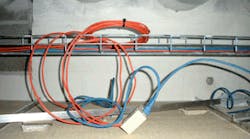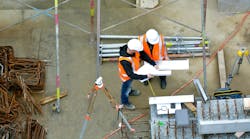For the purpose of this article, the 2008 NEC and 2006 IMC codes were used as the basis for references.
In today’s buildings, you can typically find a wide range of electronic equipment, including security cameras, audiovisual (AV) projectors, wireless access points, and ceiling-mounted speakers, hanging from the ceiling or placed above a suspended ceiling in any number of places. Due to its relatively concealed nature, however, the space above the ceiling can often become a playground for improperly installed devices, their connections, and accessories. The age-old saying “out-of-sight, out-of-mind” definitely applies to this inconspicuous area.
Before you install your next piece of equipment at or above the ceiling, it’s important to look at some of the potential issues that arise when you mount and connect the equipment. By taking a proactive approach and using proper design and planning principles, however, you can ensure a code-compliant installation.
Plenums or other air-handling spaces
Because many of today’s buildings use the space above a suspended ceiling to handle environmental air, the first — and quite possibly the most important — step in the process is to confirm if the HVAC systems will use this type of air distribution or if the building will be fully ducted. When the space above the ceiling is used for environmental air handling, building codes are usually more stringent about what may or may not be installed in the space. These requirements are necessary due to the potential for spreading smoke and/or other toxic gases to other areas of the building via the HVAC system in the event of a fire.
As always, you should refer to the local authority having jurisdiction (AHJ) to determine all applicable codes. In most cases, however, there are two main code references that dictate what you may install in these particular areas: the National Electrical Code (NEC), specifically Sec. 300.22(C) – “Other Space Used for Environmental Air,” and the International Mechanical Code (IMC), Sec. 602 – “Plenums.” Generally speaking, if not enclosed in an appropriate metallic or non-combustible enclosure, all electronic equipment wiring must be tested and listed in accordance with stringent UL standards in order to be installed in a plenum or air-handling space.
Unfortunately, it’s not uncommon to find violations of these code requirements in a newly constructed building, many of which include the supporting hardware and cabling for low-voltage systems, such as AV systems, security systems, and voice/data systems. For example, Photo 1 reveals a common violation with the installation of IP security cameras, AV projectors, and other IT equipment, such as wireless access points. These devices often include the use of proprietary cable connections (or whips) and/or the installation of cabling, jacks, modular plugs, faceplates, and outlet boxes to provide the data connections required as part of the system. Unless all of these supporting items are appropriately listed and labeled for installation in a plenum or other air-handling space, you must install them within an appropriate non-combustible enclosure. Another interesting point to note in Photo 1 is the fact that the installer left some things behind in the ceiling space upon completion of his work. Notice the discarded product packaging in the back right corner of this image, and the cardboard used to shim the supports for the camera. Not only does this situation violate code rules, but it also unnecessarily increases the potential fire load. Therefore, it should not be used, regardless of the type of air distribution system.
One commonly missed accessory in AV installations, such as sound reinforcement, public address, or mass notification systems, are the back-cans for ceiling-mounted speakers (Photo 2). These devices, which are metallic (or non-combustible) enclosures surrounding the speaker and internal components, are required when the speaker would otherwise be exposed to the air-handling space above the ceiling and has not been listed as suitable for air-handling spaces.
One of the more significant areas of concern with low-voltage devices pertains to the cabling used to interconnect them. Commonly, these cables are not required to be run in conduit (except in some jurisdictions like Chicago), but they are required to be properly supported and listed for the environment they are installed in. Most of the time, the desire to reduce costs and an increased ease of maintenance will lead to the elimination of most of the conduit used for these cables in favor of j-hooks, cable trays, or other open air hangers.
Where installed in an air-handling space (not in conduit), these cables and supports are required to be plenum rated. In most cases, this is just a matter of locating appropriately listed cables and supports; however, in the AV industry, this may be a bit more difficult. Due to the migration into the digital age, many of the cable connections are required to be done via factory terminations or use proprietary cables. Sometimes, these types of cables might not be available in plenum-rated versions, or they’ll be very difficult to find.
The alternative may be to install the cabling completely in conduit. However, the connectors can drive the size of the conduit up dramatically, depending on the number of bends required or distance between the devices. If not planned properly, this situation could present major issues during construction. If you can obtain the appropriately rated cable and use open air supports, take one final consideration into account. When cabling low-voltage devices in this manner, small items, such as zip ties, hook-and-loop straps, modular plugs, etc., can be included as part of the installation. These small items are often overlooked because they may seem insignificant to the overall concern regarding smoke and flame spread. Nevertheless, they’re still worth considering. When used, these objects can account for hundreds, if not thousands, of small combustible sources, contributing to and increasing the potential for generating toxic gases or spreading flames from one area of the building to another. If planned for up-front, you can order properly tested and listed items for use in plenum spaces.
In addition to these cabling and connection concerns, you must also review the actual equipment and its accessories for code compliance. For example, many of today’s low-power devices, such as self-amplified speakers, access control units, door locks, and wireless access points, can rely on transformers (i.e., wall warts) to provide their main or source power. Due to the often limited distances of the cords associated with these devices — or the opportunity to reduce the costs of installation — these transformers can find their way plugged into receptacles above the ceiling near the devices (Photo 2). In most cases, these devices are encased in a non-plenum-rated combustible material. Per code, these devices would be required to either be placed in an appropriate enclosure or be listed and labeled for use in a plenum.
In order to ensure a code-compliant installation, review all of the equipment listing information prior to construction. This will allow you to determine if enclosures will be necessary to house the equipment. As part of that review, it’s important to investigate the actual listing information of electronic components before they are given the green light to be installed in a plenum space. The importance of this investigation lies in the way each piece of equipment is tested and what is included as part of that test. It’s not unusual to have a piece of equipment tested without all of the necessary accessories or supporting hardware that would be required for a fully functioning system in order to achieve the plenum rating. There are instances where items such as a wireless access points have been tested and listed as a plenum device — the problem is the test may not have included the external antennas, any proprietary cabling connections, or the modular plug at the end of the cable required to function properly. This often leads to the incorrect assumption that you can place the device in a plenum, even if the other untested items are planned to be included as part of the assembly.
Raceways and other low-voltage cabling supports
How are these low-voltage cables supported and installed when there is no code requirement for conduit use? Wiring methods for these cables usually include the requirements set forth in Sec. 300.11 – “Securing and Supporting” of the NEC. Guidance is given in this section on the requirements for how supports shall be installed and what may not be used as a support. The first of two main areas commonly missed in relation to this section includes the prohibited use of the ceiling grid or assembly as a means of support; however, it is not uncommon to find low-voltage and electrical cables installed directly on the ceiling as a means of support. Photo 2 and Photo 3 provide examples of where low-voltage and MC electrical cables have been “installed” directly on the ceiling assembly in violation of this section of the NEC.
The second violation of this Code section commonly found is the use of ceiling grid support wires as a means of support for the cabling. This method of wiring is specifically prohibited unless allowed by exception. The exceptions are limited to instances where the practice is allowed by the ceiling system manufacturer and, where applicable, tested as part of the fire rated assembly. In the absence of satisfying these exceptions, you must provide independent supports for this type of equipment.
Oftentimes, you may find clips commonly referred to as “batwings,” cable ties, or other similar devices used to attach cables to the ceiling grid support wires. If the use of “batwings” is a desired method of support, it may be possible to provide identical, but additional, supports to those provided for the ceiling grid support. In certain cases, such as in a fire-rated assembly, Sec. 300.11 (1) - “Fire-Rated Assemblies” of the NEC requires these additional supports to be colored or otherwise marked differently than the ceiling grid support wires. It is, however, advisable that in all cases these supports be marked differently prior to their installation, allowing for the ease of identification by inspection officials and others attempting to determine if they are indeed additional supports.
Power connections
Power connections provided for the main or source power to an electronic device can introduce additional areas of concern related to the use of a flexible cord and power receptacle. Generally speaking, these cords and receptacles are not plenum rated. Therefore, for the reasons identified above, you may not install these types of cords and equipment above the ceiling. In addition to this — and regardless if the space is being used for air handling — according to NEC Sec. 400.8(5) – “Uses Not Permitted,” the use of a flexible cords in the concealed space above a ceiling is prohibited (Photos 2 and 3).
A common violation to this rule is frequently found in the installation of ceiling-hung AV projectors. Oftentimes, the projector is hanging from a mount below the ceiling (Photo 4) while the power cord is routed to an electrical receptacle above the ceiling (Photo 3). With proper planning, you can avoid this situation by requiring the electrical outlet to be installed in the ceiling tile with the receptacle facing the exposed side of the ceiling (Photo 5). This will eliminate the flexible cord from being concealed and enable you to avoid improperly rated combustible materials from being installed within the plenum space above the ceiling.
It’s worth noting that products do exist that have been developed, as part of the projector mounting plate, to serve as a “plenum” enclosure to house items such as the electrical outlet, flexible cords, and other AV-related equipment above the ceiling. This article does not address these enclosures, as there are a varying range of products available in the market, each with unique features that need to be evaluated prior to their use. Generally speaking, however, these enclosures do not address the concealment of flexible cables as it pertains to the NEC.
In the end
The desire to conceal equipment for aesthetic purposes or to seize an opportunity to save on installation costs will often drive the decision of where equipment is located.
In many cases, these opportunities can still be pursued with minimal impact to the design through the use of appropriately listed products and/or enclosures. But in some cases, it may be necessary to make minor compromises in the locations of certain items in order to achieve a code-compliant and safer installation.
With the proper planning and installation, you can avoid many code violations with very little effect to the project schedule or project costs. By allowing a non-compliant installation to occur, not only are you opening yourself up to potential problems and liabilities, but you’re also opening up the door to increased costs to correct any deficiencies after the fact.
Hancock is a senior technology specialist with Henderson Engineers, Inc. in Lenexa, Kan. He can be reached at [email protected].








